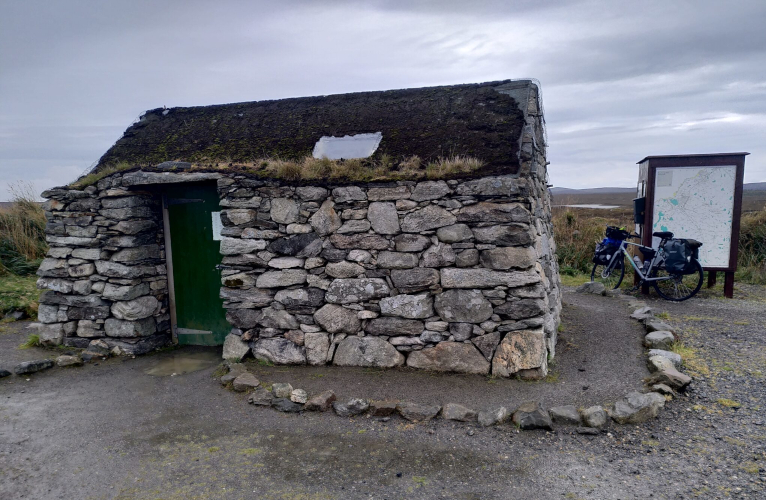
It’s time for me to break my silence here – thanks for keeping the discussion going in my absence.
Among other reasons for the pause was a long trip away, at least by my standards – mostly recreational, and mostly in Scotland. To get back into the swing of this blog I’m going to say a few things about the trip, relating them to some of the wider issues generally discussed here. Then, with publication of my new book imminent (tickets for the launch in Frome on 14 October available here – it’s free), I’ll start turning to some posts about that.
So – one part of my trip involved cycling the Hebridean Way, a 180+ mile cycle ride across the island chain of the Outer Hebrides, from Barra in the south to Lewis in the north. I was accompanied most of the way by my son, before his work as a river ecologist called him away. Part of his job involves rescuing wild salmon from the depredations of a road widening project in the Highlands, and the salmon’s call upon his time were more important than mine. At this juncture in world history, widening roads and destroying salmon habitat doesn’t seem to me a great use of precious resources, but I’ve (almost) given up on trying to make sense of modern priorities.
Anyway, one of the pleasures of the time I was able to spend with my son is his well-honed ability to spot and identify wildlife. Hence, my trip involved an impressive rollcall of accompanying characters such as sea eagles, golden eagles, short-eared owls, lapwings, snipe, ptarmigan, godwits, seals, dolphins and pine marten. Many of these creatures used to be more widely spread across the country but have now retreated to its wilder edges – not least due to farming practices geared to higher productivity, and lower price. People talk about a ‘shifting baseline syndrome’ of wildlife loss, where the relatively slow decline across human generations blinds us to the richness that’s been lost. I’d argue there’s also a shifting baseline syndrome of human economic action, which is directly causative of the former. We cannot imagine the less monetised, less energised and more localised worlds of the past involving more people and more wildlife on farms, or imagine that it’s feasible or acceptable to project such ways of being into the future.
I completed the last part of the ride to the northern tip of Lewis alone. Here’s a picture of an old shieling I came across there, which has now become a small museum. My trusty steed is visible to the right. Less than two centuries ago one branch of my family headed south from a farming life in the Scottish Highlands with similarities to this, joining the modern economy as industrial wage workers. And now here I am returning as a leisured, Lycra-clad English tourist. Again, our culture over-celebrates this shifting baseline as if it’s unambiguously good. So I was pleased that the display didn’t overdo the ‘hard and miserable life of the agrarian past’ shtick, making mention of the celebration and sense of social freedom around the shielings and common pasturage in Gaelic culture. Winters cooped up with family in lowland housing, summers spent carousing in the high pastures. Or else, in other transhumant cultures, winters spent cooped up in large communal dwellings, summers spent in smaller kin groups. Family and freedom, an essential tension.
As readers of this blog will know, I’m a cautious enthusiast for shared agrarian property rights – two cheers for the commons. I chart the contours of this enthusiasm, and this caution, in my new book. Sometimes, I fear I overdo the caution. For all my strictures against modernist politics, have I become a petty bourgeois Little Englander, obsessing over landownership and property boundaries? Well, I don’t think so. When I look at the wider global historical literature on how people organise access to productive land, I find endless iterations on the difficulties of reconciling kin and community, individual and collective, in ways that can never definitively be resolved on one side or the other. This isn’t just about modernist ultra-individualism.
I hope I’ve conveyed some of that difficulty in the new book – but perhaps it merits some further discussion here. Meanwhile, for more thoughts on the petty bourgeoisie and the future, I’ve recently put this essay out in a new publishing venture, Romanticon. There’s a lot to be learned from the Romantic movement, in its broadest sense. Good luck, then, to Romanticon.
On my way back south, I stopped off in Glencoe and spent a nice day hiking the steep ridges of Stob Coire nan Lochan and Bidean nam Bian before dropping back down through the Lost Valley – now magical, once the desperate sanctuary of the MacDonalds fleeing the Glencoe massacre. That’s a story where the villains, as is so often the case in Scottish history, were ostensibly the English, but on closer inspection, not only the English – a warning, perhaps, against overly dualistic hero and villain narratives.
Back down in the Glencoe carpark, a coach pulled up and the door opened. A man dressed to the nines in kilt and sporran jumped out and proceeded to play the bagpipes. The passengers filed out, took photos of the mountains on their phones, then filed in again, followed by the piper. The door closed and they were gone, the whole affair lasting two minutes max. Glencoe done.
But who am I to feel superior? Loving the views from the top of a mountain involves more physical exertion than loving them from the bottom but is maybe not so different otherwise. Loving the views at all is at least entry-level Romanticism of the kind that’s needed if we’re to have any hope of navigating toward a better world.
During the trip, I bought a book I’ve long been meaning to read, Soil and Soul, by Hebridean writer and land activist Alastair McIntosh, first published in 2001. I discovered that its foreword was written by a certain George Monbiot. In it, Monbiot says McIntosh’s book proves that poetry can save the world (p.xiii). There’s a different sensibility in Monbiot’s 2022 tome, Regenesis, where he writes: “one of the greatest threats to life on Earth is poetry” (p.212).
Maybe someone should write a book about the implications of this volte face. On which note, while sheltering from a storm in a youth hostel my son and I met a young woman who enquired about the work we did. When I told her that I wrote about farming and eco-politics she asked if I’d read Saying NO to a Farm-Free Future. Quite the ego boost for an obscure writer – though, as my son cruelly pointed out, my books are more likely to find a readership in the Outer Hebrides (population circa 26,000) than in, say, London (population circa 9 million), where efforts to dismiss agrarian localism as mere ‘romanticism’ and to seek industrial alternatives to farming are a surer way to find an appreciative audience. Regardless of my own modest literary efforts, I think this speaks to a wider problem of our times. Still, our new acquaintance had recently completed a master’s degree in environmental history and was searching the local landscape for evidence of old field systems. I drew comfort from her activist remembrance.
So – hard agrarian lives, old field systems, wild weather. Cycling the Hebridean Way in inclement conditions doesn’t rank too highly in the annals of human adventuring, but it was interesting all the same how the circle of my daily concerns suddenly narrowed during the trip: where will I be able to pitch my tent, do I have enough food, how will I keep dry and warm? It doesn’t surprise me at all that our ancestors in the deep past took many millennia to figure out how to survive in northern Europe. If we’re going to live up to our H. sapiens moniker, it’d be worth applying our minds to rethinking how we’ll do so in such places again with less reliance on imported energy and materials. Maybe these half-buried Hebridean field systems sing a song of the future.
I had limited access to electrical energy during my cycle ride, meaning I failed to keep as abreast of the news headlines as I usually do. But I discovered toward the end of my trip that someone I’d barely heard of had been shot dead in Utah and all hell had broken loose. For reasons logistical, personal and meteorological, when I got back to the mainland I had to spend a few days without much to do in a pretty little raincoast town, and ended up gorging myself dangerously on the social media firestorm about the killing and the wider politics that it implicated. The shooter, you see, had been consumed by far-left ideology. No wait, he’d been consumed by far-right ideology. Hang on, the shooter wasn’t actually the shooter.
I think it’s probably best if I avoid adding my redundant opinions to this pile-on. Two things I will say that it dramatized and that relate to the concerns of this blog are, first, that in politics as in farming there now seems to be a missing middle – everybody these days seems to be either ‘far left’ or ‘far right’. And this is accompanied by the conviction that the other lot’s position is twisted ‘ideology’, while one’s own is plain good sense. I plan to write more about this in a forthcoming post. Relatedly, it seems to be an open question now whether the US republic can survive given the rent in the fabric of any common political narrative. I find the writings of Christopher Armitage about blue states pulling away from the federal structure interesting in this respect. This could prove harder than he thinks, but nevertheless he traverses some similar ground to the nature of political collapse that I charted in A Small Farm Future with the concept of the ‘supersedure state’, and that I further examine in Finding Lights… with the concept of the sun polity. With Trump sending troops into ‘war-ravaged’ … er … Portland, the days of national collapse and the supersedure state seem more imminent.
Ah, collapse. While the US was convulsed with its far-left/far-right imbroglio, Britain was rehearsing its own version, with a well-attended ‘Unite the Kingdom’ rally in London, and the road system festooned with national flags.
As argued by John Harris in this interesting article, part of the ‘far-right’ narrative involves playing constantly on overwrought ideas of impending social collapse and civil disorder. Though historically ‘far-left’ narratives have also done exactly this. Anyway, Harris’s article gave me brief pause to wonder whether my own collapsenik tendencies are part of the same problematic political ecosystem. To be honest, I don’t think so. I’m not massively interested in emphasizing the impending-ness of civil disorder to found some political project of restoring a sense of the status quo ante or else some brave new world. It’s just that I can’t see how our colonial and fossil-fuel dependent world system built on economic growth will ultimately survive the social and biophysical shocks it’s bringing upon itself. But perhaps this is an issue worth discussing further.
Renegade Labour MP Clive Lewis wrote this interesting little comment about a friend of his who went to the Unite the Kingdom rally, not because he was persuaded by the ‘far-right’ messaging but because he felt the government doesn’t listen to people and because he wanted to feel proud of his country again. I hope to write more about this in a forthcoming post too – not least because I shared a stage with Clive at the Green Gathering recently and I want to dig into some of the things he said there, alongside these remarks about the rally.
Anyway, the long drive I took to Scotland (ah yes … I have my own sins to expiate), gave me the opportunity to do a bit of entirely unsystematic social science research by observing the distribution of national flags across the motorway system. It seemed to me that as I progressed northward across England the density of flags generally dwindled. Once I crossed into Scotland, I saw precisely one union flag and one Scottish Saltire. Hence, a geographic gradient of political allegiance – cast-iron proof at last that my theories of the supersedure state are well grounded.
On my way back south a couple of weeks later, almost all the flags were gone. Collapse deferred. For now.
Perhaps I’m making too light of the present grave political moment and the creeping – no, bounding – authoritarianism that’s emerging. In wealthy Global North countries, there’s little doubt in my mind that the ‘far-right’ is a greater threat than the ‘far-left’, and I do understand some of the furious backs-to-the-wall rhetoric among left-wing or ‘progressive’ (why are all political terms so deeply problematic that I feel the need to put quotation marks around them?) activists aimed at political moderates for conniving at the right-wing power grab. But this is tempered by the fact that so much left-wing thinking seems to me delusional about the reasons for its eclipse. If I were to frame it in the class terms that’s the staple of left-wing analysis, I’d say that a lot of this bears on an inability to take the petty bourgeoisie seriously or understand how complex and multifaceted petty bourgeois politics is – a theme picked up in my linked article that I hope to expand on in the future.
And so now I’m home again, back to the farm, back to the book publication, back to a million things to do, back to trying to grow some produce and grow some politics that’s not far-left or far-right but equal to the present moment by dispensing with those figments of modernism and doing my bit to articulate more vital political traditions like Romanticism and distributism. Sometimes it feels too thankless and daunting, an enterprise that invites mostly indifference, if not ridicule. How tempting to slip away and embrace a less critically-edged Romanticism. Maybe I’ll just chuck up everything and spend these sunset years swaggering the rock-strewn paths of Highland mountains. Tempting, but I probably won’t. I daresay instead I’ll stay sober and industrious, and thus ironically modernist, despite myself. I have new gardens to plant.
Teaser image credit: Author supplied.



